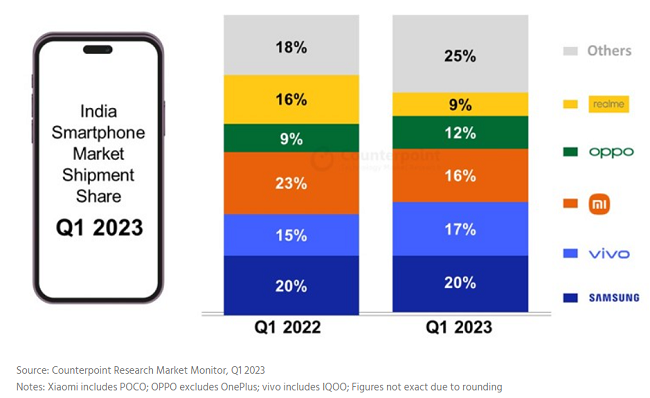The smartphone market in India recorded its highest-ever decline in Q1 2023 i.e. the period from January to March. As per Counterpoint Research’s Market Monitor, smartphone shipments in the country fell 19 percent year-on-year to 31 million units in Q1, 2023. This is also the third consecutive quarterly decline in smartphone shipments.
Smartphone shipments in India see highest decline in Q1, 2023

The reason for the decline in the Indian smartphone market is said to be due to sluggish demand, growing preference for refurbished phones, and high inventory build-up from 2022. Additionally, there is a shift in consumer behavior with demand now centered around promotional periods. Counterpoint Research forecasts a similar situation in Q2, 2023 with growth returning only in the second half of the year due to faster 5G upgrades, easing macro pressure, and the festive season.
As per the Counterpoint Research’s report, the Rs 30,000 – 45,000 and above Rs 45,000 price segments recorded 60 and 66 percent growth in shipments respectively. Meanwhile, the share of shipments in the Rs 10,000 to Rs 30,000 slipped by as much as 35 percent in Q1. 5G smartphone shipments crossed 40 percent for the first time.
South Korean major Samsung led the smartphone market in India in Q1, 2023 for the second straight quarter with a 20 percent share. It also led the 5G phone shipments with a 24 percent share. Vivo came in second place with a 17 percent share. Xiaomi fell to the third spot with a 16 percent share and a 44 percent year-on-year decline. This is due to weak demand in the sub-Rs 10,000 segment, over-dependence on online channels, and a confusing portfolio. OPPO bagged the fourth position with 12 percent share whereas Realme slipped to the fifth place with a 52 percent YoY decline.
Additionally, apart from the top five lists, OnePlus became the fastest growing brand with 72 percent YoY growth driven by Nord CE 2 Lite and OnePlus 11 series. Apple also clocked 50 percent growth. The Cupertino-based tech giant registered 32 and 62 percent shares in the premium and ultra-premium segment respectively.
Related:
- Apple Trumps Over Samsung & Sharp in Smartphone Shipments for Q4 2022
- Apple’s Q1 2023 Mac Shipments Plummet 40.5%: A Tough Blow for the Tech Giant
- Apple, Samsung, and Other Tech Giants Experience Decline in Wearables Shipments During Q4 2022





